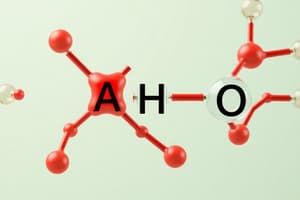Podcast
Questions and Answers
What is the general formula for alkanes?
What is the general formula for alkanes?
- CnH2n-2
- CnH2n
- CnH2n+1
- CnH2n+2 (correct)
Which of the following is the correct structural formula representation for propane?
Which of the following is the correct structural formula representation for propane?
- C3H7
- C3H8
- CH3-CH2-CH3 (correct)
- CH3-CH2-CH2
What type of hydrocarbons are alkanes?
What type of hydrocarbons are alkanes?
- Cyclic unsaturated hydrocarbons
- Acyclic saturated hydrocarbons (correct)
- Acyclic unsaturated hydrocarbons
- Cyclic saturated hydrocarbons
How many carbon atoms are in isobutane?
How many carbon atoms are in isobutane?
What distinguishes isotopes of the same element?
What distinguishes isotopes of the same element?
Which of the following best describes the difference between butane and isobutane?
Which of the following best describes the difference between butane and isobutane?
Which of the following is a characteristic of constitutional isomers?
Which of the following is a characteristic of constitutional isomers?
In a condensed structural formula, what does the notation CH3-(CH2)6-CH3 represent?
In a condensed structural formula, what does the notation CH3-(CH2)6-CH3 represent?
What geometric shape do carbon atoms form in alkanes?
What geometric shape do carbon atoms form in alkanes?
How does the number of possible isomers change as the number of carbon atoms in an alkane increases?
How does the number of possible isomers change as the number of carbon atoms in an alkane increases?
What is the maximum number of hydrogen atoms that can bond with a carbon atom in alkanes?
What is the maximum number of hydrogen atoms that can bond with a carbon atom in alkanes?
What are conformations in the context of alkanes?
What are conformations in the context of alkanes?
Which naming system is used by the International Union of Pure and Applied Chemistry (IUPAC) for organic compounds?
Which naming system is used by the International Union of Pure and Applied Chemistry (IUPAC) for organic compounds?
What are branched-chain alkanes commonly referred to?
What are branched-chain alkanes commonly referred to?
What does the prefix 'meth-' in IUPAC nomenclature indicate?
What does the prefix 'meth-' in IUPAC nomenclature indicate?
Which of the following compounds represents a continuous chain alkane?
Which of the following compounds represents a continuous chain alkane?
What is the correct IUPAC name for a compound with a four-carbon chain and a methyl substituent on carbon-2?
What is the correct IUPAC name for a compound with a four-carbon chain and a methyl substituent on carbon-2?
If a compound is named 2,3,4-Trimethylhexane, how many carbon atoms are in the longest chain?
If a compound is named 2,3,4-Trimethylhexane, how many carbon atoms are in the longest chain?
When naming a compound with multiple methyl substituents on a hexane chain, what prefix is used for three methyl groups?
When naming a compound with multiple methyl substituents on a hexane chain, what prefix is used for three methyl groups?
Why is the number '2' in the name 2-Methylbutane considered redundant?
Why is the number '2' in the name 2-Methylbutane considered redundant?
To properly name a compound with both a methyl substituent and a continuous carbon chain, which of the following steps is incorrect?
To properly name a compound with both a methyl substituent and a continuous carbon chain, which of the following steps is incorrect?
How do the boiling points of cycloalkanes compare to straight-chain alkanes of the same carbon length?
How do the boiling points of cycloalkanes compare to straight-chain alkanes of the same carbon length?
Why do branched chain alkanes have lower boiling points than straight-chain alkanes?
Why do branched chain alkanes have lower boiling points than straight-chain alkanes?
Which of the following reactions are alkanes and cycloalkanes susceptible to?
Which of the following reactions are alkanes and cycloalkanes susceptible to?
What is the result of complete combustion of alkanes in an oxygen-rich environment?
What is the result of complete combustion of alkanes in an oxygen-rich environment?
What makes halogenated alkanes more reactive than their non-halogenated counterparts?
What makes halogenated alkanes more reactive than their non-halogenated counterparts?
Which of the following statements about the boiling points of continuous chain alkanes is correct?
Which of the following statements about the boiling points of continuous chain alkanes is correct?
When naming halogenated alkanes, the order of the substituents is determined by:
When naming halogenated alkanes, the order of the substituents is determined by:
What physical property primarily contributes to the lower reactivity of alkanes?
What physical property primarily contributes to the lower reactivity of alkanes?
In IUPAC nomenclature, how should substituents be ordered when more than one kind is present?
In IUPAC nomenclature, how should substituents be ordered when more than one kind is present?
Which of the following compounds correctly uses IUPAC punctuation rules?
Which of the following compounds correctly uses IUPAC punctuation rules?
What does a line-angle structural formula represent in organic chemistry?
What does a line-angle structural formula represent in organic chemistry?
How are carbon atoms classified based on their bonding?
How are carbon atoms classified based on their bonding?
What is a characteristic of primary carbon atoms?
What is a characteristic of primary carbon atoms?
Which of the following is true about branched-chain alkyl groups?
Which of the following is true about branched-chain alkyl groups?
Which IUPAC name violates the naming rules?
Which IUPAC name violates the naming rules?
In IUPAC nomenclature, how should numbers be separated?
In IUPAC nomenclature, how should numbers be separated?
Flashcards are hidden until you start studying
Study Notes
Alkanes: Acyclic Saturated Hydrocarbons
- Alkanes have the general formula CnH2n+2, where n represents the number of carbon atoms.
- Each carbon in an alkane is tetrahedral, meaning it has four bonds to other atoms.
Structural Formulas
- Chemical formulas indicate the type and number of elements in a compound.
- Structural formulas show the connection between atoms in a molecule.
- Expanded structural formulas illustrate all bonds explicitly.
- Condensed structural formulas simplify the representation, especially for longer carbon chains.
- Molecular formulas present the simplest representation, showing only the elements and their quantities.
Alkane Isomerism
- Alkane isomers have the same molecular formula but differ in the arrangement of their atoms.
- Straight-chain or unbranched alkanes have carbon atoms in a continuous series.
- Branched-chain alkanes have carbon atoms arranged with branches.
- Constitutional isomers differ in their atom-to-atom connectivity.
- The number of possible isomers increases with the number of carbon atoms in the alkane.
Conformations of Alkanes
- Conformations refer to specific 3D arrangements of atoms in molecules resulting from rotation around single C-C bonds.
- Rotation around C-C single bonds allows for different spatial arrangements of atoms while maintaining the same chemical connectivity.
IUPAC Nomenclature for Alkanes
- IUPAC nomenclature provides a systematic naming system for organic compounds.
- Prefix names (e.g., meth-, eth-, prop-) indicate the number of carbon atoms in the longest continuous chain.
- Substituents, groups attached to the main chain, are named according to the number of carbon atoms and their position on the chain.
- IUPAC rules ensure consistent and unambiguous naming of complex molecules.
Line-Angle Structural Formulas
- Line-angle structural formulas represent carbon-carbon bonds with straight lines.
- Each point in the diagram represents a carbon atom with four bonds to other atoms.
- C-H bonds are implied and not explicitly shown.
Classification of Carbon Atoms
- Carbon atoms in organic structures are classified based on the number of other carbon atoms directly bonded to them:
- Primary (1o) C: bound to one other carbon atom.
- Secondary (2o) C: bound to two other carbon atoms.
- Tertiary (3o) C: bound to three other carbon atoms.
- Quaternary (4o) C: bound to four other carbon atoms.
Branched-Chain Alkyl Groups
- Branched-chain substituents are named based on the parent alkane from which they are derived.
- Examples include isopropyl, tert-butyl, etc.
Boiling Points of Alkanes and Cycloalkanes
- Boiling points increase with increasing chain length or ring size.
- Cycloalkanes have higher boiling points than the corresponding acyclic alkanes due to their rigidity.
- Branched-chain alkanes have lower boiling points than straight-chain alkanes due to their more compact structure and reduced surface area.
Chemical Properties of Alkanes and Cycloalkanes
- Alkanes and cycloalkanes are relatively unreactive due to their nonpolar C-C and C-H bonds.
- They are resistant to most reactions, with notable exceptions being combustion and halogenation.
Combustion Reactions
- Combustion reactions involve the reaction of alkanes and cycloalkanes with oxygen (O2) to produce carbon dioxide (CO2) and water (H2O).
- Complete combustion requires a sufficient amount of oxygen, resulting in the formation of CO2.
- Incomplete combustion, with limited oxygen, may lead to the production of carbon monoxide (CO) or other carbon-containing products.
Nomenclature and Properties of Halogenated Alkanes
- Halogenated alkanes (or haloalkanes) contain at least one halogen atom.
- Halogens are treated as substituents in naming, with prefixes fluoro-, chloro-, bromo-, and iodo-.
- Halogenated alkanes are more reactive than alkanes and cycloalkanes due to the polar C-X bond (X = halogen).
Studying That Suits You
Use AI to generate personalized quizzes and flashcards to suit your learning preferences.




